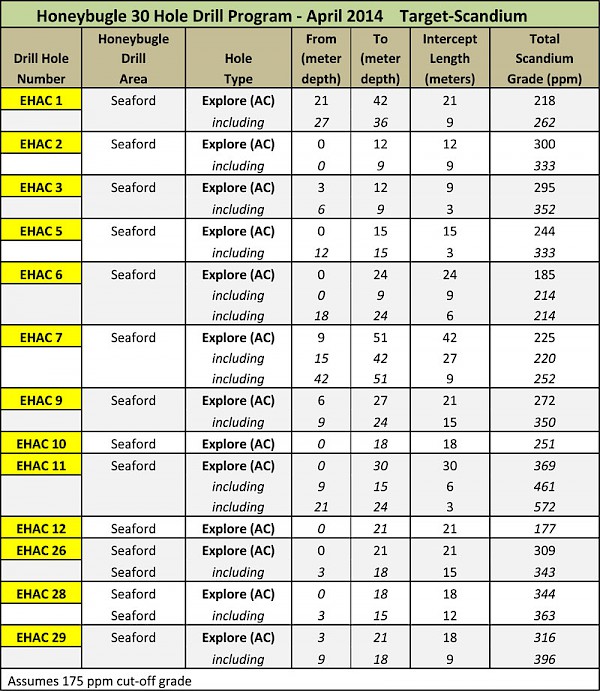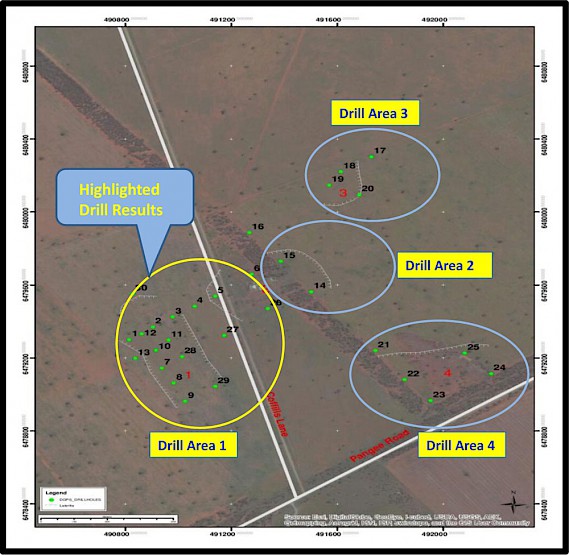News Releases
Reno, Nevada - May 7, 2014 - EMC Metals Corp. (the "Company" or "EMC") (TSX: EMC) is pleased to announce completion of an initial program of 30 air core (AC) drill holes at its Honeybugle property (Exploration License: EL7977) in New South Wales (NSW), Australia, targeting scandium (Sc). Results on 13 of these holes are shown in detail, in the table below. These holes suggest the potential for scandium mineralization on the property similar to the Nyngan Scandium property, also controlled by EMC, which is 24 kilometers north of Honeybugle.
Highlights of initial drilling program results:
- The highest 3-meter intercept graded 572 ppm scandium (hole EHAC 11)
- EHAC 11 also generated two additional high grade scandium intercepts, grading 510 ppm and 415 ppm, each over 3 meters,
- The program identified a 13-hole cluster which was of particular interest;
- intercepts on these 13 holes averaged 270 ppm scandium over a total 273 meters,
- at an average continuous thickness of 21 meters per hole,
- representing a total of 57% (354 meters) of total initial program drilling.
- The 13 holes produced 29 individual (3-meter) intercepts over 300 ppm, representing 31% of the mineralized intercepts in the 273 meters of interest, and
- This initial 30-hole AC exploratory drill program generated a total of 620 meters of scandium drill/assay results, over approximately 1 square kilometer on the property.
The results of 13 holes in the initial drill program are as follows:
Discussion of Initial Drill Program and Results
The Honeybugle tenement contains lateritic material common to the region, and is situated some 24 kilometers south of EMC's Nyngan Scandium Project area. The property itself is located in semi-arid broad-acre wheat farming country and is routinely planted. Farming is the largest industry in the area, although other mining activity is evident, past and present. The area had been receiving significant rainfall, which affected the areas which could be accessed with the drill rig and ultimately some of the drill hole locations.
The tenement is large, encompassing 34.7 square kilometers, and includes four (4) distinct magnetic anomalies; Seaford, Woodlong, Yarran Park and Mallee Valley, which reflect underlying mafic to ultramafic bedrock. These areas were previously identified by groups exploring principally for platinum, nickel and cobalt in the 1980's, but scandium was of little interest. Surface soil and rock chip sampling conducted by previous license holders and EMC, on each of the four areas, did detect anomalous scandium values that are well above background levels (20-30 ppm). The previous soil sampling work on the property is what led to EMC's interest in acquiring the Honeybugle exploration tenements, and in conducting a small and targeted drill program, starting with the Seaford anomaly.
Seaford is characterised by extensive outcrops of dry, iron-rich laterites, allowing for a particularly shallow drill program. Thirty (30) air core (AC) holes on nominal 100-meter spacing were planned, over an area of approximately 1 square kilometer. Four holes were halted in under 10 meters depth, based on thin laterite beds, low scandium grades, and shallow bedrock.
The 13 holes highlighted in the table are grouped together on either side of Coffills Lane, and represent all of the drill locations where meaningful intercept thickness generated scandium grades exceeding 175 ppm. Some of these 13 holes showed significant scandium values on the immediate surface, and alternately, other holes exhibited favorable scandium grades that began at shallow depth. The highest grade Sc sample was found in a 21-24 meter interval (572 ppm), although several holes produced better than 350 ppm Sc intercepts at depths of under 9 meters. The deepest hole (EHAC 7) was drilled to 57 meters, showing good scandium grades over a 12-meter horizon (245 ppm) near the bottom of the hole, from 39 to 51 meters depth. Higher scandium grades were associated with higher iron levels. Holes were drilled to a depth where they contacted the fresh ultramafic bedrock, which generally signalled the end of any scandium enrichment zones.
The drill plan divided Seaford into four sub-areas, 1-4, as highlighted on the map below. Area 1 was relatively higher ground and therefore the least impacted by ground moisture. Consequently this dryer area received the greatest attention, although that had been the general intention in the plan. Area 1 received 17 holes, with 13 presented in detail in the table above. Areas 2-4 were each intended as step-out areas that need to be further examined in the next program. The three step-out areas did not generate results of particular note, although hole locations were not optimal due to ground conditions and access.
- Area 2 received 3 holes, 60 meters total, and generated Sc grades from 45-75 ppm,
- Area 3 received 4 holes, 87 meters total, and generated Sc grades from 47-122 ppm,
- Area 4 received 5 holes, 72 meters total, and generated Sc grades from 60-101 ppm, and
- The average depth of all of these holes was 18 meters, with the deepest 30 meters.
Figure 1: Initial Drill Program Map
This 13-hole cluster (Area 1) was noted to be in a relatively thick laterite zone which was constrained to the west by contact with metasediments, to the east by fresh ultramafic bedrock, and to some extent in the north by a poor intersection result in hole 30. Area 1 remains somewhat open to the south, with the two southern-most holes (EHAC 9 and EHAC 29) generating some of the best scandium grade intercepts in the area.
The surface and near surface mineralization at this property is an advantage, both in locating areas of interest for future exploration work, and also because of extremely low overburden ratios. This particular characteristic for the Honeybugle property is different to EMC's Nyngan property, where mineralization is typically covered by 10-20 meters of barren alluvium.
EMC takes the same interpretive view of Honeybugle that we have on our Nyngan resource, in that 100 ppm scandium values represent a good cut-off grade for targeting and ultimately for resource development. Grades between 50 and 100 ppm represent areas where weathering of the bedrock has been effective in upgrading scandium, and should garner exploration interest. Areas indicating 100 to 200 ppm scandium represent potentially attractive locations for soil sampling and targeted investigation, and areas that show 200 to 350 ppm scandium assays represent unusual concentration levels that should receive priority drill work programs.
Further drilling at Seaford is warranted, based on the results of this introductory and modest program, specifically to the north and south of the existing area 1 drill pattern, along with investigation and select drilling at the other three remaining anomalies on the property. The geologic consultants who designed the initial drill program have also recommended that a more complete sample analysis be undertaken, specifically where the 3-meter composite samples gave scandium grades ≥ 80ppm. The stored bulk samples provide an opportunity to re-measure scandium grades on a 1-meter interval basis, for the same suite of elements.
EMC's CEO, George Putnam, commented as follows:
"The initial drilling results at Honeybugle have produced encouraging results for scandium, both on grade and intercept length, and we now have a property that absolutely warrants further drill work. The property fits into our scandium strategy well, based on the similarities to and synergies with our NI 43-101 resource up the road at Nyngan, potentially expanding the district for future EMC scandium production from multiple sources."
Qualified Person and Quality Assurance/Quality Control
John Thompson, B.E. (Mining); Vice President - Development at EMC Metals Corp is a qualified person as defined in NI 43-101 and has reviewed the technical information in this press release.
The drilling, sampling, packaging and transport of the drill samples was carried out to industry standards for QA/QC. EMC employed an independent local geology consulting and drill supervisory team, Rangott Mineral Exploration Pty. Ltd., (RME) of Orange, NSW, Australia, to manage the drill work on-site. Bulk samples of drill returns were collected at one metre intervals from a cyclone mounted on the drilling rig, and a separate three-tier riffle splitter was used on site to obtain 2.0-4.5kg composite samples collected over 3 metre intervals, for assay. Individual sample identifiers were cross-checked during the process. The assay samples were placed in sealed polyweave bags which remained in RME's possession until the completion of the drilling program, at which time they were transported to RME's office in Orange. There, the sequence of sample numbers was validated, and the assay samples were immediately submitted to Australian Laboratory Services' (ALS') laboratory in Orange. The remnant bulk samples, which were collected in sealed polythene bags, were transported by RME to a local storage unit at Miandetta, for long-term storage.
ALS/Orange dried and weighed the samples, and pulverised the entire sample to 85% passing 75 microns or better (technique PUL-21). These 50g sample bags of pulps were then sent to the ALS laboratory at Stafford in Brisbane, Queensland for analysis. ALS/Brisbane analysed the pulps for scandium, nickel, cobalt, chromium, iron and magnesium, using Inductively Coupled Plasma Atomic Emission Spectroscopy (ICP-AES) after a four acid (total) digestion (technique ME-ICP61). The lower detection limit for scandium using this technique is 1ppm. For their internal quality control, ALS/Brisbane added 4 standard samples (for 20 repeat analyses), 10 blank samples and 16 duplicate samples to the batch.
About EMC Metals Corp.
EMC is a specialty metals development company focussed on the development of scandium properties worldwide. The Company's primary project is the Nyngan Scandium Project in NSW, Australia, with a NI 4-101 Resource filed on SEDAR. Nyngan is controlled 100% by EMC, subject to US$2.5M in settlement payments due in mid 2014.
In addition to Nyngan, EMC owns 100% of two other scandium exploration properties, Tordal Scandium/REE in southern Norway, and Honeybugle, in NSW, Australia, in close proximity to Nyngan. EMC's objective is to bring into production the world's first principal scandium mine, to service worldwide markets in aluminum alloys and energy applications.
For additional information please contact:
EMC Metals Corp.
Investor Relations-Nevada: (775) 355-9500 or info@emcmetals.com ,
No stock exchange, securities commission or other regulatory authority has approved or disapproved the information contained herein.
This press release contains forward-looking information that does involve various risks and uncertainties regarding future events. Such forward-looking information can include without limitation statements regarding long term prices for scandium, our ability to find and retain qualified management and key technical persons to operate various scandium projects, our ability to raise the necessary capital to fund development of mining operations, the short term or long term economic feasibility of scandium production at any one or all of our scandium properties, and in general statements based on current expectations involving a number of risks and uncertainties and are not guarantees of future performance. Forward-looking information in this press release is based on estimates and opinions of management on the dates they are made and are expressly qualified in their entirety by this notice, and by other risk factors disclosed in our public filings. Except as required by law, EMC assumes no obligation to update forward-looking information should circumstances or management's estimates or opinions change.


